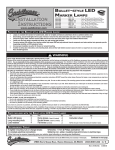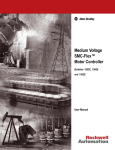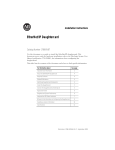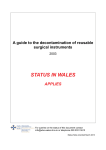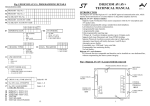Download 1502-UM051_-EN-P - Rockwell Automation
Transcript
Medium Voltage Contactor 800A, 2400-7200 V Bulletin 1502 (Series D and E) User Manual Important User Information Read this document and the documents listed in the Additional Resources section about installation, configuration, and operation of this equipment before you install, configure, operate, or maintain this product. Users are required to familiarize themselves with installation and wiring instructions in addition to requirements of all applicable codes, laws, and standards. Activities including installation, adjustments, putting into service, use, assembly, disassembly, and maintenance are required to be carried out by suitably trained personnel in accordance with applicable code of practice. If this equipment is used in a manner not specified by the manufacturer, the protection provided by the equipment may be impaired. In no event will Rockwell Automation, Inc. be responsible or liable for indirect or consequential damages resulting from the use or application of this equipment. The examples and diagrams in this manual are included solely for illustrative purposes. Because of the many variables and requirements associated with any particular installation, Rockwell Automation, Inc. cannot assume responsibility or liability for actual use based on the examples and diagrams. No patent liability is assumed by Rockwell Automation, Inc. with respect to use of information, circuits, equipment, or software described in this manual. Reproduction of the contents of this manual, in whole or in part, without written permission of Rockwell Automation, Inc., is prohibited. Throughout this manual, when necessary, we use notes to make you aware of safety considerations. WARNING: Identifies information about practices or circumstances that can cause an explosion in a hazardous environment, which may lead to personal injury or death, property damage, or economic loss. ATTENTION: Identifies information about practices or circumstances that can lead to personal injury or death, property damage, or economic loss. Attentions help you identify a hazard, avoid a hazard, and recognize the consequence. IMPORTANT Identifies information that is critical for successful application and understanding of the product. Labels may also be on or inside the equipment to provide specific precautions. SHOCK HAZARD: Labels may be on or inside the equipment, for example, a drive or motor, to alert people that dangerous voltage may be present. BURN HAZARD: Labels may be on or inside the equipment, for example, a drive or motor, to alert people that surfaces may reach dangerous temperatures. ARC FLASH HAZARD: Labels may be on or inside the equipment, for example, a motor control center, to alert people to potential Arc Flash. Arc Flash will cause severe injury or death. Wear proper Personal Protective Equipment (PPE). Follow ALL Regulatory requirements for safe work practices and for Personal Protective Equipment (PPE). Allen-Bradley, Rockwell Software, Rockwell Automation, and TechConnect are trademarks of Rockwell Automation, Inc. Trademarks not belonging to Rockwell Automation are property of their respective companies. Table of Contents Chapter 1 Contactor Product Description Scope .............................................................................................................................. 1-1 Description .................................................................................................................... 1-1 Vacuum Bottle Description ........................................................................................1-2 Contactor Operation Electro-Mechanical Control (Series D) ...........................................................1-3 IntelliVAC Control (Series E) ............................................................................1-4 Contactor Identification ............................................................................................. 1-6 Contactor Catalog Number Explanation ............................................................... 1-6 Contactor Specifications ............................................................................................ 1-7 Products Approvals .......................................................................................................1-8 Chapter 2 Receiving and Handling Receiving ........................................................................................................................ 2-1 Preliminary Inspection ........................................................................................2-1 Handling ........................................................................................................................ 2-1 Pre-Energization Inspection ...................................................................................... 2-2 Storage ............................................................................................................................ 2-2 Vacuum Bottle Integrity Test ..................................................................................... 2-3 Insulation Resistance Test .......................................................................................... 2-5 Chapter 3Installation Mounting ....................................................................................................................... 3-1 Electrical Connections ................................................................................................ 3-2 Wiring and Schematic Diagrams: Series D • Electrically Held Contactor (normal drop-out time) ............... 3-4 Series D • Electrically Held Contactor (fast drop-out time) ...................... 3-5 Series E • Electrically Held Contactor ............................................................ 3-6 Series D • Mechanical Latch Contactor ......................................................... 3-7 Series E • Mechanical Latch Contactor .......................................................... 3-8 Typical Electrical Diagrams: Series D • Electrically Held Contactor (normal drop-out time) ............... 3-9 Series D • Mechanical Latch Contactor ....................................................... 3-10 Series E • Electrically Held Contactor .......................................................... 3-11 Series E • Mechanical Latch Contactor ........................................................ 3-12 1502-UM051E-EN-P – June 2013 ii Table of Contents – 800 A Medium Voltage Contactor User Manual Chapter 4Maintenance Tool Requirements ...................................................................................................... 4-1 Recommended Torque Values ................................................................................... 4-1 Routine Maintenance .................................................................................................. 4-1 Vacuum Bottle Replacement and Set-up Procedure ............................................. 4-3 Main Coil Replacement Procedure ........................................................................ 4-11 Mechanical Latch Trip Coil Replacement Procedure .........................................4-15 Mechanical Latch Roller Replacement Procedure ...............................................4-17 Mechanical Latch Mechanism Refurbishing Procedure .....................................4-17 Altitude Adjustment ................................................................................................. 4-18 Drop-out Time Conversion .....................................................................................4-20 Auxiliary Contact Replacement and Set-up Procedure ......................................4-21 Chapter 5Troubleshooting Troubleshooting • Table 5.A ..................................................................................... 5-1 Typical Contactor Coil Impedance Values • Table 5.B ....................................... 5-1 Chapter 6 Renewal Parts 800A Electrically Held Vacuum Contactor ........................................................... 6-1 Mechanical Latch Assembly ..................................................................................... 6-1 Renewal Parts List • Table 6.A ................................................................................. 6-2 1502-UM051E-EN-P – June 2013 Chapter 1 Contactor Product Description Scope This User Manual pertains to Allen-Bradley's Bulletin 1502, 800A vacuum contactors. It applies to both Series D and E versions of the Bulletin 1502 (800 Amp) contactors. Series D vacuum contactors are intended for use with electro-mechanical (relay) control circuits. They may not be used with IntelliVAC and IntelliVAC Plus control modules. Series E vacuum contactors are used with IntelliVAC and IntelliVAC Plus control only (refer to publications 1503-UM053_-EN-P and 1503-UM054_-EN-P respectively). Description Allen-Bradley's Bulletin 1502, 800 amp electrically held and mechanical latch vacuum contactors are designed for high horsepower applications in the 2400 to 7200 voltage range. These contactors are suitable for all types of AC loads, for example: three phase motors, transformers, power capacitors and resistive heating loads. Mechanically latched contactors are used mainly in situations requiring the contactor to remain closed in the event of power failure. The contactor uses three (3) interrupters (hereafter referred to as vacuum bottles) operated by an electromagnet assembly through a mechanical linkage. They are resistant to adverse atmospheric conditions and provide a long mechanical and electrical life. The contactors are utilized in various starter and drive configurations, e.g. full voltage non-reversing, full voltage reversing, two-speed, reduced voltage, synchronous, drive input/output and bypass applications. They are fixed mounted within the structures and the line and load terminations are made at the rear of the device. In most configurations, the main contactor is mechanically interlocked with the external operating handle and isolating switch. Figure 1.1 – 800A Contactor 1502-UM051D-EN-P – December 2009 1-2 Contactor Product Description Vacuum Bottle Description The vacuum bottle (Figure 1.2) consists of two contacts enclosed in a ceramic housing. One contact is mounted on a fixed shaft, and the other is attached to a movable shaft. The bearing and stainless steel bellows ensure that the movable contact tracks accurately and maintains vacuum integrity within the bottle. Fixed shaft Ceramic Arc shield Contacts Bellows Bearing 1502-UM051E-EN-P – June 2013 Movable shaft Figure 1.2 – Typical Vacuum Bottle Cross Section Contactor Product Description 1-3 Contactor Operation The standard electrically held contactor consists of three vacuum bottles operated by an electromagnet assembly through a mechanical linkage (See Figure 1.3). Electro-Mechanical Control (Series D) • When the control circuit is energized, current flows through both a closing coil and hold-in coil, creating an electromagnet. • This electromagnet pulls the armature plate towards the coil cores which also rotates the actuator shaft. • The actuator plate, in turn, pushes the insulator and movable shaft up, closing the contacts inside the vacuum bottle. • The control circuit economizing/auxiliary contacts, located on the left side of the contactor, change state once the contactor closes. • The current that is energizing the closing coil is then switched off. The contactor remains closed by the hold-in coil only. • The contactor is opened by de-energizing the hold-in coil. The mechanical latch version of the contactor operates basically the same way with the following exceptions: • Both coils are de-energized upon closing of the contactor, and the armature is held in the closed position by a spring-loaded latching mechanism. • The contactor is opened by energizing a trip coil which pulls the latch away from the armature, or by engaging a manual trip mechanism via a pushbutton located on the front of the medium voltage door (see Figure 1.4). Note: External control relays and a rectification circuit are used to control the standard DC closing and hold-in coils on the contactor. 1502-UM051E-EN-P – June 2013 1-4 Contactor Product Description Contactor Operation (cont.) IntelliVAC Control (Series E) The electrically held vacuum contactor operates as follows: • When the IntelliVAC and IntelliVAC Plus control modules receive a close command, the contactor coil is energized, the current creates an electromagnet in the coil. • The electromagnet pulls the armature plate towards the coil core, rotating the shaft and causing the actuator plate to move upwards. • As the actuator plate moves, it pushes the insulator and movable shaft up, closing the contacts in the vacuum bottle. • The IntelliVAC and IntelliVAC Plus control modules supply the close current to the coil for approximately 200 milliseconds. Afterward, the coil current is reduced to a lower hold-in value. • When the IntelliVAC and IntelliVAC Plus control modules have the close command removed, the coil is de-energized, opening the contactor. The mechanical latch contactor operates in much the same manner as the electrically held version (see above) with a few exceptions: • Once the contactor is closed, a spring-loaded mechanism moves a roller against the armature plate to hold it against the electromagnetic core. • The contactor can be opened electrically by energizing a trip coil (via IntelliVAC and IntelliVAC Plus 'open' output) which pulls the latch away from the armature, or by a push button mounted on the power cell door that mechanically releases the contactor. Line Terminal Vacuum Bottle Insulator Load Terminal Actuator Plate Flexible Bus Armature Plate and Shaft Magnet/Coil Assembly Armature Stop Return Spring Compression Bolt 1502-UM051E-EN-P – June 2013 Return Spring Figure 1.3 – Vacuum Contactor Operation Contactor Product Description Latch Lever 1-5 Latch Spring Mechanical Latch Trip Coil Manual Trip Mechanism Contactor Closed Figure 1.4 – Top Partial Section View Showing Mechanical Latch 1502-UM051E-EN-P – June 2013 1-6 Contactor Product Description Contactor Identification Each contactor is identified with a nameplate (Figure 1.5) attached to the interphase barrier retainer at the front of the contactor. The nameplate information includes the Catalog Number, Series Letter, Voltage Rating, Non-enclosed Current Rating, Interrupting Capacity, Altitude Range, CSA and UL markings. VACUUM CONTACTOR CONTACTEUR SOUS VIDE CAT. 2500- IEC60470 C US E102991 LR12235 MADE IN CANADA 3Ø V. AMP. INTERRUPTING CAPACITY POUVOIR DE COUPURE ALTITUDE RANGE PLAGE D'ALTITUDE SER. 50/60 HZ. AMP. M. READ INSTRUCTIONS BEFORE ENERGIZING THIS DEVICE.MAY PRODUCE HARMFUL X-RAYS. LIRE LES INSTRUCTIONS AVANT D'ALIMENTER CET APPAREIL. DES RAYONS X DANGEREUX PEUVENT SE PRODUIRE Catalog No. Explanation The following catalog number explanation will help identify the contactor and shall be used when contacting your local Rockwell Automation Sales office or the factory for assistance. 1502 - Figure 1.5 – Contactor Label V 8 First P o sitio n S e co n d P o sitio n Th ird P o sitio n Fo u rth P o sitio n B ullet in N um ber C ontac t or Ty pe and Interloc k C ontac t or S ize N om inal Line V olt a g e 8 = 800 A D = 7200 V 1502 V = Vacuum , no inter lock D X A - 1 Fif th P o sitio n S ixth P o sitio n S e ve n th P o sitio n E ig h th P o sitio n F us e M o u n t ing P rov is ions C oil V olt a g e F unc t ion A lt it u d e C ode (m et ers ) Refer to Table 1.A 1= 2= 3= 4= 5= X = N one VC = Vacuum , O ptim ized for IntelliVAC ™ contr ol Table 1.A – Vacuum Contactor Function A = 3 p o le, elec trically h eld c ontactor B= 3 p o le, m ec h an ically latc hed contac tor with elec trical an d mec hanical releas e D = 3 p o le, elec trically h eld c ontactor w ith fas t d rop -out tim e 1502-UM051E-EN-P – June 2013 D D = 110 V D C ( 120 V AC ) E = 207 V D C ( 230 V AC ) 0 – 1000 1001–2000 2001–3000 3001–4000 4001–5000 Contactor Specifications Contactor Product Description 1-7 Table 1.B - Bulletin 1502 Medium Voltage 800 Amp Contactor Ratings Description Voltage Ratings Maximum Rated Voltage System Voltages Dielectric Voltage Withstand Rating Basic Impulse Level (B.I.L.) Withstand Frequency Ratings Current Ratings Rated Continuous Current (Amps) Maximum Interrupting Current Rating Maximum Interrupting MVA Rating Short-Circuit Withstand at Rated Voltage Short Time Current Rating Capability For 60 seconds (kV) Phase to Ground, Phase to Phase (kV) Hertz 2400 V (RMS Sym Amps) 5000 V (RMS Sym Amps) 7200 V (RMS Sym Amps) 2400 V (Sym MVA) 5000 V (Sym MVA) 7200 V (Sym MVA) Current Peak ½ cycle (kA) For 1 second (kA) For 30 seconds (kA) Chop Current (Average RMS Amps) Make and Break Capability at Rated Voltage (kA) Ambient Temperature °C Contactor Coil Data (Series E) Control Voltage Coil Voltage (VCL) (VCTL) VAC: 110 to 240 VAC or 110 to 250 VDC 120 VAC VCL = 2 X VCTL (Max.) VDC: VCL = VCTL 110 VDC Contactor Coil Data (Series D) Control Voltage Coil Voltage (VCL) (VCTL) 120 VAC/ 230 VAC 110 VDC/ 208 VDC Close Current (ADC, 200 milliseconds) Hold Current (ADC) Pick-up Voltage Drop-out Voltage Trip Current (ADC, 200 milliseconds) Trip Voltage Close Current (ADC) Hold Current (A DC) Trip Current (ADC) Pick-up Voltage Trip Voltage Coil Inrush Current (A) – Electrically Held Coil Inrush Current (A) – Mechanical Latch Coil Inrush Current (A) – Mechanical Latch Trip Coil Continuous Current (A) Coil Pick-up Voltage (VAC) Coil Drop-out Voltage (VAC) Specifications 7200 2400 3300 4800 6600 18.2 / 20 (IEC) 60 50 / 60 4160 6900 800 12,500 12,500 12,500 50 100 150 85 12.0 4.8 0.5 8.0 40 12 0.7 95 75 5.2 70 13.1 0.24 5.6 102 84 13.1 / 7.1 13.1 / NA 5.6 / NA 0.24 / 0.13 102 / 196 75 / 145 The voltage and current ratings listed are valid up to 1,000 m (3,300 feet). Please refer to Table 1.C – Altitude Derating Chart, on page 1-8 for ratings above this altitude. Control voltage, as measured at the input of the IntelliVAC or IntelliVAC Plus control module. Provided that regular maintenance is performed. A contactor drop-out delay may be configured with the IntelliVAC control module (refer to publication 1503-UM053_-EN-P), or the IntelliVAC Plus control module (publication 1503-UM054_-EN-P). FDO = Fast Drop-Out. NDO = Normal Drop-Out. The number of contactor auxiliary contacts depends on the contactor type. Some of the contacts are used in the typical control schemes used. 1502-UM051E-EN-P – June 2013 1-8 Contactor Product Description Contactor Specifications (cont.) Table 1.B - Bulletin 1502 Medium Voltage 800 Amp Contactor Ratings (cont.) Description Specifications Operational Characteristics Mechanical Life (Operations) x 1000 Electrical Life (Operations) x 1000 Switching Frequency (Operations per hour) Opening and Closing Times (Series E) Maximum Closing Time Maximum Opening Time (without delay) Opening and Closing Times (Series D) Maximum Closing Time (120 VAC) Maximum Opening Time (Normal Drop Out) Maximum Opening Time (Fast Drop Out and Mechanical Latch) Capacitor Switching (max. KVAR) System Voltage Electrically Held Mechanical Latch Electrically Held Mechanical Latch 250 100 250 600 150 120/240 VAC (milliseconds) 150 120 to 240 VAC (milliseconds) 60 50 or 60 Hz (milliseconds) 200 50 or 60 Hz (milliseconds) 240 50 or 60 Hz (milliseconds) 60 2400 V 4160 V 6900 V 2000 3000 4000 General Standard Altitude Capability (meters / feet) -1,000 to 5,000 / -3,300 to 16,500 Contactor Weight (kg / lbs) 45 / 100 Auxiliary Contact Rating A600 Auxilairy Contacts on the Vacuum Contactor (Max.) 3 N.O. / 3 N.C. The voltage and current ratings listed are valid up to 1,000 m (3,300 feet). Please refer to Table 1.C – Altitude Derating Chart on Product Approvals 1502-UM051E-EN-P – June 2013 page 1-8 for ratings above this altitude. Control voltage, as measured at the input of the IntelliVAC and IntelliVAC Plus control modules. Provided that regular maintenance is performed. A contactor drop-out delay may be configured with the IntelliVAC and IntelliVAC Plus control modules (refer to publications 1503-UM053_-EN-P and 1503-UM054_-EN-P). FDO = Fast Drop-Out. NDO = Normal Drop-Out. The number of contactor auxiliary contacts depends on the contactor type. Some of the contacts are used in the typical control schemes used. Altitude adjustment required. • UL347 • CSA22.2 No. 14 and T.I.L. D-21 • IEC60470 • CE Mark Chapter 2 Receiving and Handling Receiving Before leaving the factory, the contactors have been tested both mechanically and electrically. Immediately upon receiving the contactor, remove the packing material and check the contactor for possible shipping damage. If damage is found, do not discard any of the packaging material and, if possible, note the damage on the Bill of Lading before accepting receipt of the shipment. Report any damage immediately to the claims office of the common carrier. Provide a description of the damage and as much identification as possible. Preliminary Inspection • Check for any cracks or breaks due to impact. • Push on armature plate to ensure mechanisms are in good working order. • Use a HiPot tester to ensure vacuum bottle integrity (refer to Vacuum Bottle Integrity Test later in this chapter). Handling The contactor weighs approximately 42 kg (93 lb) and it is feasible for two (2) people to safely handle the contactor for a short duration (injury may occur should one person attempt to handle the equipment). The following procedure shall be used if a crane or hoist is used to handle the contactor. 1. Insert two (2) 3/8”-16 UNC lifting bolts into the holes provided on the top of the contactor (Figure 2.1) and attach the lifting means to the contactor with ropes or cables. Use rigging with safety hooks or shackles. Figure 2.1 – Lifting Holes 1502-UM051E-EN-P – June 2013 2-2 Receiving and Handling Handling (cont.) 2. Select or adjust the rigging lengths to compensate for an unequal weight distribution of the load and maintain the contactor in an upright position at all times. 3. To reduce the tension of the rigging and the compressive load on the lifting device, do not allow the angle between the lifting cables and vertical to exceed 45 degrees. 4. Never lift a contactor above an area where personnel are located. When a forklift is used to handle the equipment, the following considerations should be taken: 1. Keep the contactor in an upright position. 2. Carefully balance the contactor on the forks. 3. Use a safety strap when handling to steady the contactor and avoid shifting or tipping. 4. Avoid excessive speeds and sudden starts, stops and turns when handling the contactor. 5. Never lift a contactor above an area where personnel are located. Pre-energization Inspection Before placing the contactor in service, inspect it carefully for possible damage sustained in transit or during maintenance: • • • • Storage If it is necessary to store the contactor before it is put into service, be certain to store it in a clean, dry, dust and condensation free area. Do not store the contactor outdoors. Storage temperature should be maintained between -20°C to 75°C (-4°F to 149°F). If storage temperature fluctuates or if humidity exceeds 85%, space heaters should be used to prevent condensation. Preferably, the contactor should be stored in a heated building having adequate air conditioning. 1502-UM051E-EN-P – June 2013 Check that all interphase barriers are correctly installed. Check housing for any cracks or breaks due to impact. Push on the armature plate, rotating shaft to ensure mechanism is in good working order. Inspect the contactor for dirt, stray loose hardware, tools or metal chips and, if necessary, vacuum clean. Vacuum Bottle Integrity Test Receiving and Handling 2-3 The internal dielectric condition and vacuum integrity of the vacuum bottles is determined by this test. Clean the outside of the vacuum bottles with a nonlinting cloth or industrial type wiper before performing the test. Test each bottle individually during this test. S H O C K H A Z A R D X-ray emissions may be produced if a voltage higher than 25,000 Volts is applied across the open contacts of a vacuum bottle. The vacuum bottles are tested thoroughly at the factory ATTENTION prior to shipment. However, the bottles can be damaged by mishandling during shipment. This damage may not be visible, so this test should be performed before the contactor is energized for the first time and each time it is returned to service after maintenance, adjustment, or repair. Otherwise, this test should be performed annually. Caution should be exercised during this test since high voltage testing is potentially hazardous. High-potential test instruments can be purchased to perform the vacuum bottle integrity test. A megger can not be used to measure vacuum integrity because the megger voltage is too low. One of the following Hi-pot testers is recommended as a test instrument. MANUFACTURER ADDRESS Mitsubishi Type VI #4U17 Jennings Model JHP-70A Hipotronics Model 7BT 60A Chicago, Ill., USA San Jose, CA., USA Brewster, NY, USA 1502-UM051E-EN-P – June 2013 2-4 Receiving and Handling Vacuum Bottle Integrity Test S H O C K H A Z A R D High-voltage is present during this test. Caution should (cont.) be exercised during this test since high voltage testing is potentially hazardous. ATTENTION Before doing any work on the contactor, the controller isolating switch must be in the open position and locked out. If any control power is used from a separate source, it should also be isolated. It is also suggested that a “Hot Stick” be used to ensure equipment is voltage free. 1. The contactor may be tested while it is in the power cell. The line connection of the contactor must be disconnected and the ground lead from the Hi-pot tester must be connected to the load side of the contactor. 2. With the contactor in the open position, connect the test leads to the contactor power terminals as shown in Figure 2.2. It is recommended that an AC hi-pot tester be used. Apply 16 kV for 60 seconds and monitor the leakage current. It should not exceed 5 mA. 3. If no breakdown occurs, the bottle is in an acceptable condition. If a breakdown occurs, the bottle should be replaced. Note: Rockwell Automation recommends that, if the contactor has been in service, all three (3) bottles be replaced at the same time. 4. After the HIGH POTENTIAL VOLTAGE is removed from the bottles, the metal end caps of the bottles should be discharged with a grounding rod to remove any residual electrical charge. 1502-UM051E-EN-P – June 2013 Figure 2.2 – Vacuum Bottle Integrity Test Circuit Receiving and Handling 2-5 The allowable leakage current of 5 mA is a maximum for new dry equipment, and is exclusive of leakage due to test equipment leads. The test setup leakage can be determined by running the dielectric test with test leads not connected to the contactor and noting the maximum leakage current. If this value is more than 2 milliamperes, it should be added to the 5 mA limit when testing the vacuum bottles. NOTE: Rockwell Automation does not recommend DC HiPot testing because the values obtained during the test are not a reliable indication of vacuum bottle integrity. DC HiPot testing is unreliable due to the occurrence of a phenomenon known as Cathode Ray Tube Effect. This occurs when one contact of the vacuum bottle has a deformity, such as a burr or deposit, while the other contact remains flat and true. This sets up leakage currents which flow from a small surface to a large surface in one direction and vice versa when the polarity of the tester is changed. The resultant current is large in one direction which would indicate, incorrectly, a faulty vacuum bottle. At best, DC testing will verify vacuum integrity if both contact surfaces are perfectly smooth. It will not, however, give any indication of the degree of vacuum since the contact surface can feasibly change with each operation of the vacuum contactor. AC testing, on the other hand, will provide reliable vacuum integrity indication. As well, the degree of vacuum within the bottle can be determined by comparing initial test results to the present readings. Increases in leakage current indicates a reduction in vacuum within the vacuum bottle. For these reasons, Rockwell Automation recommends AC testing as the only reliable method of testing vacuum bottles. Insulation Resistance Test Using a 1000 volt Megger, the resistance from phase to phase or phase to ground shall be greater than 500 megohms. 1502-UM051E-EN-P – June 2013 Chapter Installation Mounting 3 The Allen-Bradley vacuum contactor is normally fixed mounted (bolted down) in the enclosure of the controller. There are four (4) mounting holes at the base of the contactor (Figure 3.1) to secure it to the enclosure. For reversing, autotransformer and 2-speed controllers, one contactor may be mounted on top of the other. There are four (4) threaded mounting holes at the top of the contactor to accommodate this configuration. IMPORTANT: The contactor is a bolted assembly and is therefore subject to twisting if fastened to an uneven surface. The contactor mounting plate has small stand-offs that permit the contactor to be fastened without twisting the frame. The contactor may not function correctly if it is forced onto an uneven mounting surface. 38,1 [1.50] (Typical Terminal Detail) 19,1 [0.75] 13,49 [0.531] 19,1 [0.75] 31,8 [1.25] 152,4 [6.00] (Mounting Hole Centers) 97,2 [3.83] Dimensions = mm [inches] 12,7 [0.50] 17,5 [0.69] 437,1 [17.21] 14.27 [0.562] (4) Mounting Holes 324,2 [12.77] 260,7 [10.27] 194,1 [7.64] 16,7 [0.66] 457.2 [18.00] (Mounting Hole Centers) 462,5 [18.21] 32,4 [1.27] 104,2 [4.10] 127 [5.00] 41,3 [1.63] 127 [5.00] 438,7� [17.27] 267,31� [10.52] 158,2� [6.23] 194,1 [7.64] 270 [10.63] Figure 3.1 – Contactor Mounting Details 1502-UM051E-EN-P – June 2013 3-2 Installation Electrical Connections The control wiring from the low voltage panel to the contactor is made through a wire harness and connects to the left side of the contactor with a male and female configured wire plug. The power wiring terminates on the rear side of the contactor to the line and load terminals. Holes are provided to accommodate 12 mm (1/2 in.) size hardware (Figure 3.2). Figure 3.2 – Electrical Connections 1502-UM051E-EN-P – June 2013 Installation 3-3 Mechanical Latch Assembly Rating Label Housing Assembly Lifting Hazard Label Terminal Block Assembly Shaft Assembly Contactor Mounting Hole Figure 3.3 – Electrical Connections 1502-UM051E-EN-P – June 2013 3-4 Installation Wiring and Schematic Diagrams Figure 3.4 – Wiring and Schematic Diagram • Series D Electrically Held Contactor (normal drop-out time) 1502-UM051E-EN-P – June 2013 Installation 3-5 WIRING DIAGRAM 800A VACUUM CONTACTOR AUXILIARY CONTACTS A B I J K L YELLOW BLUE C COIL MOV YELLOW BLACK D P E F G H MOV N A B C D E F G H I J K L M N P A, B, C, D, E, F, G, H, I - SOCKETS J, K, L, M, N, P - PINS SCHEMATIC 800A VACUUM CONTACTOR AUXILIARY CONTACTS M A B M F E M H G M J I M K L MOV C CC D MOV N HC P M CC - CLOSING COIL HC - HOLD-IN COIL 80113-646-28 Figure 3.5 – Wiring and Schematic Diagram • Series D Electrically Held Contactor (fast drop-out time) 1502-UM051E-EN-P – June 2013 3-6 Installation Figure 3.6 – Wiring and Schematic Diagram • Series E, Electrically Held Contactor 1502-UM051E-EN-P – June 2013 Installation 3-7 Figure 3.7 – Wiring and Schematic Diagram • Series D Mechanical Latch Contactor 1502-UM051E-EN-P – June 2013 3-8 Installation Figure 3.8 – Wiring and Schematic Diagram • Series E, Mechanical Latch Contactor 1502-UM051E-EN-P – June 2013 Installation 3-9 Typical Electrical Diagrams Figure 3.9 – Typical Electrical Diagram for 800 amp FVNR Controller (Series D Electrically Held Contactor, 120 VAC, normal drop-out time) 1502-UM051E-EN-P – June 2013 3-10 Installation Figure 3.10 – Typical Electrical Diagram for 800 amp FVNR Controller (Series D Mechanical Latch Contactor, 120 VAC) 1502-UM051E-EN-P – June 2013 Installation 3-11 Figure 3.11 – Typical Wiring and Schematic Diagram for 800 amp FVNR Controller (Series E • Electrically Held Contactor) 1502-UM051E-EN-P – June 2013 1502-UM051E-EN-P – June 2013 Figure 3.12 – Typical Wiring and Schematic Diagram for 800 amp FVNR Controller (Series E • Mechanical Latch Contactor) 1 1 ISb 30 1A F3 4.0A 8 2400V-6900V,3Ø, 50/60Hz L1 L2 L3 GRD 9 E X F J M (8) (5) M OL OL 2.0A F7 (7) (6) 35 31 2A 14 X 10 7 5 ISa 120 V ____ V I STOP D START D 15 M 13 3 2 + EC L1 11 AUX 12 1 2 V 11 6 F2 __E K TEST SUPPLY POINT TS 120V 60Hz CPT1 500 VA CURRENT LIMITING PRIMARY FUSES F2 __E F1 CURRENT LIMITING POWER FUSES F1 F1 ISOLATING SWITCH IS DOOR INTERLOCK G M-IV 4 3 6 CCO 5 TCO 17 19 C D M M-IV CC MOV TC MOV (3) (1) OFF (4) (2) X M-IV CLOSE D D G R OPEN 7 + - V OFF RUN 8 A B M TEST 9 + - 10 V X NORMAL 20 21 12 12 12 42 MAIN CONTACTOR (M) 49 OL 592 OVERLOAD M MANUAL TRIP 44 AUX CCO EC M-IV TCO V D 46 G N M M M P L H EXTRA AUXILIARY CONTACTS 34A 37 33 T3 T2 T1 MTR - INTELLIVAC MODULE VACUUM CONTACTOR AUXILIARY INPUT - INTELLIVAC MODULE CLOSING COIL OUTPUT - INTELLIVAC MODULE EXTERNAL CAPACITOR INPUT - MAIN CONTACTOR INTELLIVAC MODULE - INTELLIVAC MODULE TRIP COIL OUTPUT CONTACTOR STATUS - FAIL SAFE MODULE STATUS - FAIL SAFE INTELLIVAC TO BE PROGRAMMED/CONFIGURED BY THE CUSTOMER BEFORE START-UP. INTELLIVAC NOTES: OUTPUT RELAY CONTACTS SHOWN WITHOUT CONTROL POWER APPLIED. THE FOLLOWING FACTORY INSTALLED CONFIGURATION/POWER-UP STATES ARE IN EFFECT: LEGEND CUSTOMER WIRING LOW VOLTAGE DOOR MOUNTED DEVICE REMOVE JUMPER WHEN CONNECTING REMOTE EQUIPMENT "IEEE" NUMBER FOR PROTECTIVE DEVICE REMOTE EQUIPMENT 34 32 CT3 CT2 CT1 47 3-12 Installation Chapter 4 Maintenance Tool Requirements When maintenance is performed on the vacuum contactor, one or all of the following tools may be required. • • • • • • • • • • Recommended Torque Values Part of the contactor may have to be disassembled for maintenance or replacement. There are appropriate torque requirements for particular bolt sizes when reassembling the contactor. For the following bolt sizes, use the specified torque values listed below: 3/8" drive ratchet wrench with extension 3/8" drive torque wrench Standard 3/8" drive sockets; 7/16", 9/16", 3/4" Open end wrenches: 7/16", 9/16", 11/16", 3/4", 7/8" 3/16" Allen key 3/16" dia. rod Slot head screwdrivers; 1/8" wide, 1/4" wide Feeler gauge set (0.125" and 0.300") Digital caliper capable of depth measurement High potential tester 1/4” Hardware 3/8” Hardware 1/2” Hardware 6 ft-lb (8 N-m) 20 ft-lb (27 N-m) 48 ft-lb (65 N-m) Routine Maintenance The following should be carried out on an annual basis or whenever a contactor is serviced: Cleaning • Ensure that metal chips or filings are cleaned from around the electromagnet assembly (coil core pole face and mating armature plate) as they may affect proper operation of the contactor. If necessary, vacuum clean. Note: Do not use compressed air to clean or remove dirt from surfaces or the enclosure as it will only redistribute the dirt. • If dirty, clean the white ceramic area of vacuum bottles with a clean lint-free cloth. 1502-UM051E-EN-P – June 2013 4-2 Maintenance Routine Maintenance (cont.) Main Contact Inspection • HiPot Test (Refer to Chapter 2) • • Lubrication Visually inspect the wear of the main contacts with the contactor energized. When any part of the wear indicator line, located on the front side of the hex shaft, moves up into the bearing, replace all three vacuum bottles. (Refer to Figure 4.11) Under normal conditions, this will not be necessary until the contactor has gone beyond the 250,000 rated life (100,000 for mechanical latch contactors). Check the vacuum bottle integrity. Check the insulation resistance. Note: Lubrication of the contactor is not necessary. Do not grease the armature shaft plastic bearings, nor the vacuum bottle plastic bearings. The grease will dry out and impede the free motion of the contactor. Mechanical Latch Roller Replacement • The roller on the mechanical latch mechanism must be replaced every 50,000 operations. See Mechanical Latch Roller Replacement Procedure (refer to page 4-17). S H O C K H A ZAR D A TTE NTION 1502-UM051E-EN-P – June 2013 High voltage may be present, which can result in severe injury or death. It is suggested that a “Hot Stick” be used to ensure that the equipment is dead. Lock-out any incoming power and disconnect the control plug from the contactor before working on this equipment Before performing any maintenance on the contactor that is installed inside a starter configuration, for safety, be sure to follow all procedures noted in the appropriate User Manual for complete instructions on accessing the power cell compartment. Maintenance 4-3 Vacuum Bottle Replacement Set-Up Procedure The following procedure shall be used to remove and replace the vacuum and bottles. This procedure can be performed with the contactor remaining in the power cell of the controller. After this procedure has been completed, the contactor will be set up to operate properly at 1000 m (3300 ft). Refer to the Altitude Adjustment procedure for other altitude setting on page 4-18. 1. Before removing the vacuum bottles, mark the installed bottles clearly to avoid confusing them with the replacement vacuum bottles. A TTE NTION For the safety of the maintenance personnel, remove the control wiring from the contactor by disconnecting the control wire plug before starting any disassembly of the contactor. 2. Remove the front retaining brace and all four interphase barriers as shown in Figure 4.1. Interphase Barriers Retaining Brace Figure 4.1 – Removal of Interphase Barriers 1502-UM051E-EN-P – June 2013 4-4 Maintenance Vacuum Bottle Replacement and Set-up Procedure (cont.) 3. Loosen the locking nut on the return spring compression bolt and withdraw the compression bolt until the return spring is relaxed. Remove the return spring as shown in Figure 4.2. Compression Bolt and Locking Nut Return Spring Figure 4.2 – Removal of Return Spring 4. Remove the bolts which retain the load terminals at the rear of the contactor and the main mounting bolt at the top of one vacuum bottle as shown in Figure 4.3 (if the contactor is still mounted in the controller, disconnect cables from the load terminals first). Vacuum Bottle Mounting Bolt Load Terminal Retaining Bolt and Nut 1502-UM051E-EN-P – June 2013 Figure 4.3 – Mounting and Retaining Bolt Removal Maintenance 4-5 5. Slide the vacuum bottle assembly out of the contactor as shown in Figure 4.4 (the overtravel spring may need to be compressed slightly). Repeat this for the remaining vacuum bottle assemblies. Vacuum Bottle Assembly Overtravel Spring Figure 4.4 – Removal of Vacuum Bottle Assembly 6. Disassemble one assembly at a time as shown in Figure 4.5. Leave the gap adjustment nut directly below the rocker washer on the insulator stud near the bottom. Vacuum Bottle Load Terminal (flexible) Lock-washer Load Terminal Nut Insulator Wear Washer Overtravel Spring Rocker Washer Gap Adjustment Nut Lock-washer Gap Locking Nut Figure 4.5 – Vacuum Bottle Assembly 1502-UM051E-EN-P – June 2013 4-6 Maintenance Vacuum Bottle Replacement 7. Reassemble the assembly using a new vacuum bottle, leaving the bottom gap locking nut and lock washer off. Position the insulator to achieve the 243.3 mm (9.58 in.) dimension as shown in Figure 4.6 and leave the load terminal nut loose (the position of the load terminal shall be in the opposite direction of the wear indicator line on the movable shaft). Repeat this procedure for the remaining vacuum bottle assemblies. and Set-up Procedure (cont.) The 9.58" dimension is not critical, it is simply a good starting point in order to make the installation easier. Movable Shaft 9.58” (243.3 mm) Load Terminal Load Terminal Nut Figure 4.6 – Reassembled Vacuum Bottle Assembly 8. Position a 4.76 mm (0.1875 in.) diameter rod, e.g. drill bit or screw, between the armature plate and the yoke plate to prevent the contactor from closing as shown in Figure 4.7. Yoke Plate Armature Plate (Position 3/16” rod here) Figure 4.7 – Set-up Position 1502-UM051E-EN-P – June 2013 Maintenance 4-7 9. Position the middle vacuum bottle assembly (phase B) in the contactor. Ensure that the rocker washer is below the actuator plate and that the wear indicator line is facing towards the front. Install and torque the load terminal retaining bolt and the vacuum bottle mounting bolt to 20 ft•lb (27 N•m). 10. With the armature plate held tightly against the 3/16” rod, turn the insulator as required such that the bottom of the overtravel spring touches the surface of the actuator plate inside the counter bore. The spring must be held securely in place, slightly compressed (as shown in Figure 4.8). Tighten the load terminal nut. Actuator Plate Load Terminal Nut Overtravel Spring touches surface of counterbore Rocker Washer Figure 4.8 – Insulator/Actuator Plate Set-up 11. With the armature plate still held tightly against the rod, turn the gap adjustment nut until the rocker washer makes contact with the round rocker bar as shown in Figure 4.9. Install the lockwasher and gap locking nut and tighten the two nuts against each other making sure that the top gap adjustment nut does not turn. Note: Ensure that the overtravel spring is held securely in place with no play. Should there be play in the positioning of the spring, loosen the load terminal nut and repeat Steps 10 and 11. 1502-UM051E-EN-P – June 2013 4-8 Maintenance Vacuum Bottle Replacement and Set-up Procedure (cont.) Rocker Bar Rocker Bar Rocker Washer Gap Adjustment Nut Side View Gap Locking Nut Front View Figure 4.9 – Rocker Washer Adjustment 12. Repeat steps 9, 10 and 11 for the remaining vacuum bottle assemblies. Note: Make sure that the rocker washers for all three assemblies just make contact with the rocker bars as this will ensure synchronized contact movement. 13. REMOVE THE 3/16” ROD DRILL BIT OR SCREW INSERTED IN STEP 8 FROM BETWEEN THE ARMATURE AND YOKE PLATES. 14. Move the actuator plate up and down manually and check that the rocker washers make contact simultaneously. If they do not, loosen the nuts below the appropriate washers and adjust accordingly. 15. Reinstall the return spring and advance the compression bolt until the armature plate makes contact with the stop as shown in Figure 4.10. Advance the bolt one additional full turn to ensure that the contactor opens fully. Holding the Compression bolt in position with a wrench, tighten the compression bolt locking nut. 1502-UM051E-EN-P – June 2013 Maintenance 4-9 Armature plate Stop Armature plate makes contact with Stop Figure 4.10 – Return Spring Installation 16. With the contactor in the open position, measure the distance between the bottom of the bearing and the top of the wear indicator line on all three vacuum bottles with a feeler gauge. This dimension shall be 7.6 mm (0.300 in.) minimum as shown in Figure 4.11. 7.6 mm (0.30 in.) Min. Vacuum Bottle Wear indicator line on operating shaft Insulator Figure 4.11 – Vacuum Bottle Contact Gap (Front View) 1502-UM051E-EN-P – June 2013 4-10 Maintenance Vacuum Bottle Replacement and Set-up Procedure (cont.) If the dimension is less than 7.6 mm (0.300 in.), loosen the gap locking nut on all three (3) bottles. Starting on phase B, turn the gap adjustment nut upwards until 7.6 mm (0.300 in.) is achieved. Repeat this procedure for phases A and C, ensuring that the measurements are equal for all three (3) phases. Tighten and torque the gap locking nuts for all three (3) phases. Note: Ensure that the armature plate is solidly positioned against the stop and compress the return spring further if necessary. Note: Account for all tools, including the set-up rod, used during the above procedure. If any tools are unaccounted for, do not energize the equipment. 17. Using the “TEST” control circuit in the starter, energize the contactor and check for minimum allowable overtravel on all three vacuum bottle assemblies with a feeler gauge. The overtravel dimension shall be 2.5 mm (0.100 in.) minimum as shown in Figure 4.12. 2.5 mm (0.100 in.) Min. 2.5 mm (0.100 in.) Min. Side View Front View Figure 4.12 – Minimum Allowable Overtravel If the overtravel dimension is less than 2.5 mm (0.100 in.), leave the contactor energized and loosen the load terminal nut on all three (3) phases. Turn the insulator downwards on phase B until the dimension of 2.5 mm (0.100 in.) is achieved, then tighten the load terminal nut. Repeat this procedure for phases A and C, ensuring that the measurements are equal for all three (3) phases. Tighten and torque the gap locking nuts on all three (3) phases. Note: Both the 7.6 mm (0.300 in.) and 2.5 mm (0.100 in.) dimensions must be achieved for proper function. If it is not possible to achieve these dimensions, consult your local Rockwell Automation field support representative. 1502-UM051E-EN-P – June 2013 Maintenance 4-11 18. Operate the contactor several times to ensure proper function. 19. Wipe down the exterior surface of each vacuum bottle with a clean lint-free cloth. 20. Replace the interphase barriers and retaining brace. 21. Again, account for all tools used during the above procedure. If any tools are unaccounted for, do not energize the equipment. Main Coil Replacement A TTE NTION Before beginning work on the contactor, ensure that it is Procedure isolated from all power sources and locked out. For the safety of maintenance personnel, remove the control wiring from the contactor by disconnecting the control wire plug before starting any disassembly of the contactor. 1. Disconnect the coil leads from the terminal block assembly. The closing and hold-in coils are both wound on one bobbin, therefore, all four coil leads must be removed (the MOVs and/or bridge diode leads may come loose as well). See Figures 4.15 to 4.19 for the appropriate connections. 2. Remove the three bolts from the bottom of the magnet assembly and withdraw the assembly from the contactor as shown in Figure 4.13. Terminal block assembly Magnet assembly Figure 4.13 – Magnet Assembly Removed 1502-UM051E-EN-P – June 2013 4-12 Maintenance Main Coil Replacement 3. Remove the two bolts which connect the magnet core to the core mounting plate as shown in Figure 4.14. 4. Slide the core out of the coil as shown in Figure 4.14. If there is a tight fit, tap the core out with a hammer. Procedure (cont.) Hold-in Coil Core Core Closing Coil Coil Lead Coil Leads Mounting Plate Mounting Plate Series E Series D Figure 4.14 – Magnet Assembly 5. Slide the core into the new coil with the mounting hole end located towards the closing coil. Ensure that the coil leads are oriented properly with respect to the core mounting holes. 6. Bolt the core to the mounting plate and position the magnet assembly in the contactor. Install the three (3) bolts which retain the assembly and torque all bolts to 20 ft-lb. 7. Referring to Figures 4.15 and 4.16 for Series D or Figure 4.17 for Series E electrically held contactors, connect the leads from the coil to the terminal block assembly as follows: Series D: • Closing coil (yellow lead) to “C” • Closing coil (black lead) to “D” • Hold-in coil (yellow lead) to “P” • Hold-in coil (blue lead) to “N” Series E: • Closing coil (yellow lead) to “C” • Closing coil (black lead) to “N” 1502-UM051E-EN-P – June 2013 Maintenance 4-13 Referring to Figure 4.18 for Series D or Figure 4.19 for Series E mechanically latched contactors, connect the leads from the coil to the terminal block assembly as follows: Series D: • Closing coil (yellow lead) to "H1" • Closing coil (black lead) to "H2" • Hold-in coil (yellow lead) to "C1" • Hold-in coil (blue lead) to "C2" • Trip Coil (white lead) to "D" • Trip Coil (blue lead) to "B" Series E: • Closing coil (yellow lead) to "C" • Closing coil (black lead) to "A" • Trip Coil (white lead) to "D" • Trip Coil (blue lead) to "B" Note: The contactor will have either a high density (1492-HC6) or a regular (1492-HJ86) terminal block. The wiring convention is the same for both types. Closing coil (yellow lead) Closing coil (black lead) Hold -in coil (yellow lead) MOVs Hold -in coil (blue lead) Figure 4.15 – Terminal Block Assembly (Electrically held Series D Contactor, regular terminal block) Note: Figures 4.15 and 4.16 show the fast drop-out configuration. The normal drop-out contactor has only one (1) MOV. Closing coil (yellow lead) Closing coil (black lead) Hold -in coil (yellow lead) Hold -in coil (blue lead) MOVs Figure 4.16 – Terminal Block Assembly (Electrically Held Series D Contactor, high density terminal block) 1502-UM051E-EN-P – June 2013 4-14 Maintenance Main Coil Replacement Procedure (cont.) Yellow Black Figure 4.17 – Terminal Block Assembly (Electrically Held Series E Contactor) Trip Coil (blue lead) Trip Coil (white lead) Closing Coil (black lead) Closing Coil (yellow lead) Hold-in Coil (blue lead) Hold-in Coil (yellow lead) Figure 4.18 – Terminal Block Assembly (Mechanically Latched Series D Contactor) B White A C Blue D Black Yellow Trip Coil Main Coil 1502-UM051E-EN-P – June 2013 Figure 4.19 – Terminal Block Assembly (Mechanically Latched Series E Contactor) Maintenance 4-15 8. The closing coil is the larger of the two (Series D only) and is located toward the front of the contactor. Refer to the appropriate wiring diagram (Chapter 3 – Installation) to ensure that the bridge diode and/or MOV leads are properly connected and for complete control wiring details. 9. Ensure that all leads, diodes and MOVs are secured tightly. Operate the contactor several times to ensure that the core is located properly. Mechanical Latch Trip Coil A TTE NTION Before beginning work on the contactor, ensure that it is Replacement Procedure isolated from all power sources and locked out, and that the contactor is in the open (or tripped) state. Core Mounting Plate Trip Coil (core hidden) Manual Trip Guide Block Yoke Plate Manual Trip Actuator Latch Lever Assembly Latch Roller Figure 4.20 – Mechanical Latch Assembly 1. Disconnect the trip coil leads from the terminal block assembly. The trip coil leads are the blue and white wires connected to terminals "B" and "D" respectively (see Figure 4.18 or 4.19). Cut any wire ties fastening the leads to the contactor base. 2. Remove latch pivot bolt with a 3/16" Allen key as shown in Figure 4.21, and remove the lever assembly. The latch spring is no longer retained at this point and may fall out of the core – do not misplace this spring. 3. Remove the trip core mounting bolt as shown in Figure 4.22 and slide the core out of the coil allowing the coil to be removed. 4. Slide the core into the new coil and install the core mounting bolt. 1502-UM051E-EN-P – June 2013 4-16 Maintenance Mechanical Latch Trip Coil Replacement Procedure (cont.) 5. Make sure that the latch spring is seated properly in the core, position the lever assembly and install the latch pivot bolt. The spring must be seated properly in the retaining holes in both the core and the lever. 6. Route the trip coil leads as they were and connect to the terminal block assembly as shown in Figure 4.18 or 4.19. Latch Pivot Bolt Latch Spring Lever Assembly Figure 4.21 – Mechanical Latch Trip Coil Replacement Trip Core Mounting Bolt Trip Coil Trip Core Latch Spring Figure 4.22 – Mechanical Latch Trip Coil Replacement 1502-UM051E-EN-P – June 2013 Maintenance 4-17 Mechanical Latch Roller Replacement Procedure 1. Make sure the contactor is in the open (or tripped) state. 2. Remove latch pivot bolt with a 3/16" Allen key as shown in Figure 4.21, and remove the lever assembly. The latch spring is no longer retained at this point and may fall out of the core – do not misplace this spring. 3. Remove the roller mounting bolt as shown in Figure 4.23 allowing the roller to be removed. 4. Insert the new roller and install the roller mounting bolt. 5. Make sure that the latch spring is seated properly in the core, position the lever assembly and install the latch pivot bolt. The spring must be seated properly in the retaining holes in both the core and the lever. Latch roller Trip Coil Lever Roller mounting bolt Figure 4.23 – Mechanical Latch Assembly Mechanical Latch Mechanism With the exception of the roller, the latch mechanism will last the rated life of the contactor. If the contactor is used beyond the rated life, the latch mechanism should be refurbished by replacing the lever assembly, latch spring and the armature plate. These parts can be ordered pre-assembled as Refurbishing Kit #80158-058-51. 1. Remove latch pivot bolt with a 3/16" Allen key as shown in Figure 4.21, and remove the lever assembly. The latch spring is no longer retained at this point and can be removed and discarded. 2. Make sure that the new latch spring is seated properly in the core; position the new lever assembly and install the latch pivot bolt. The spring must be seated properly in the retaining holes in both the core and the lever. 3. Loosen the locking nut on the return spring compression bolt and withdraw the compression bolt until the return spring is relaxed. Remove the return spring as shown in Figure 4.2. 4. Remove the armature plate mounting bolts. Discard the armature plate and install the new armature plate. Reinstall the return spring and advance the compression bolt until the armature plate makes contact with the stop as shown in Figure 4.10. Advance the bolt one additional full turn to ensure that the contactor opens fully. Holding the compression bolt in position with a wrench, tighten the compression bolt locking nut. 1502-UM051E-EN-P – June 2013 Refurbishing Procedure 4-18 Maintenance Altitude Adjustment Vacuum contactors are sensitive to the altitude at the installation site. This is due to the fact that the atmospheric pressure assists in closing the main contacts by exerting force on the bellows at the movable end of the vacuum bottles. Since this force is proportional to the difference between internal bottle pressure and external atmospheric pressure, the return spring must be adjusted for the appropriate altitudes. Contactors are factory set for the altitude at which they are originally installed. If a contactor is relocated to a different altitude range (see Table 4.A), a spring adjustment is necessary for proper operation. The following procedure shall be used to make the correct settings. 1. Determine what altitude range the contactor is set up for by checking the rating label (also refer to the Catalog Number Explanation). 2. Measure and record dimension “A” as shown per Figure 4.24. Note: Dimension “A” will vary from contactor to contactor, there is no predetermined value. A Locking Nut Return Spring Compression Bolt Figure 4.24 – Return Spring Assembly 1502-UM051E-EN-P – June 2013 3. Loosen the compression bolt locking nut and adjust the position of the compression bolt according to Table 4.A. Dimension “A” is changed by the amount shown on the table. For example, if the contactor’s existing range is 0-1000 m and the desired range is 3000-4000 m, increase dimension “A” by 4.93 mm (0.194 in.). If the contactor’s existing range is 4000-5000 m and the desired range is 2000-3000 m, decrease dimension “A” by 2.69 mm (0.106 in.). After dimension “A” has been set for the desired altitude range, re-tighten the locking nut. Maintenance 4-19 Table 4.A – Dimension “A” Settings in Inches (millimeters in brackets) EXISTING ALTITUDE RANGE NEW ALTITUDE RANGE Increase or Decrease Dimension “A” by: 1000-2000 m 2000-3000 m 3000-4000 m 0-1000 m 4000-5000 m 0-1000 m N/A +0.073 (1.85) +0.140 (3.56) +0.194 (4.93) +0.246 (6.25) 1000-2000 m -0.073 (-1.85) N/A +0.067 (1.70) +0.121 (3.07) +0.173 (4.39) 2000-3000 m -0.140 (-3.56) -0.067 (-1.70) N/A +0.054 (1.37) +0.106 (2.69) 3000-4000 m -0.194 (-4.93) -0.121 (-3.07) -0.054 (-1.37) N/A +0.052 (1.32) 4000-5000 m -0.246 (-6.25) -0.173 (-4.39) -0.106 (-2.69) -0.052 (-1.32) N/A 4. On the rating label, change the catalog number (altitude suffix), the stated altitude range and the current rating. Refer to Table 4.B for the derated continuous current and B.I.L. withstand ratings for each altitude range. A TTE NTION A contactor will only function properly in the altitude range for which it is set up. If functional tests are required, they must be performed at the proper altitude or in a pressure chamber which simulates the proper altitude. Table 4.B – Contactor Deratings Altitude Range Continuous Current Rating B.I.L. Withstand Rating 0-1000 m 800 A 60 kV 1000-2000 m 780 A 54 kV 2000-3000 m 760 A 48 kV 3000-4000 m 740 A 42 kV 4000-5000 m 720 A 36 kV 1502-UM051E-EN-P – June 2013 4-20 Maintenance Drop-out Time Conversion Series D The average normal drop-out time for the contactor is 200 ms. The "fast dropout" contactor has a drop-out time less than 60 ms. Conversion from "normal" to "fast" or vice-versa is easily achieved by changing the control component wired in parallel with the closing coil (see Figures 3.3 and 3.4). The required components can be ordered from Rockwell Automation and installed per the appropriate schematic. Normal drop-out parts: (1) Rectifier bridge (1) Mounting screw (1) Wire assembly (1) Wire assembly 24808-451-01 M-8765 80018-457-32 80018-457-33 Fast drop-out parts: (1) MOV assembly 80145-581-03 The rectifier bridge for the normal drop-out mounts on the outside of the left side plate above the auxiliary assembly (mounting hole provided). The MOV for the fast drop-out mounts directly on the terminal blocks as shown in Figures 4.15 and 4.16. Series E Contactor drop-out times are set within and controlled by the IntelliVAC or IntelliVAC Plus control modules (refer to publications 1503-UM053_-EN-P or 1503-UM054_-EN-P). 1502-UM051E-EN-P – June 2013 Maintenance 4-21 Auxiliary Contact Replacement and Set-Up Procedure 1. If replacing a single contact cartridge, remove the appropriate leads and turn the plastic retaining screws to allow removal of the cartridge as shown in Figures 4.25 and 4.26. Insert the new cartridge and position the retaining screws to hold it in place. Reconnect the leads to the cartridge. Ensure that the cartridge is in the proper configuration (the top cartridges are normally closed, the bottom cartridges are normally open, refer to Figure 4.27). The “normal” state is when the contactor is “off ” (open position). To remove cartridge, turn retaining screws. Figure 4.25 – Retaining Screws Auxiliary contact removed Figure 4.26 – Cartridge Removal Note: 2. If replacing the entire auxiliary assembly, remove the leads from all cartridges and remove the assembly complete with mounting plate by removing the mounting bolts as shown in Figure 4.27. For Series E contactors, the top auxiliary contact position must use a 700-CP1 cartridge. All other positions must use 700-CPM cartridges. 1502-UM051E-EN-P – June 2013 4-22 Maintenance Auxiliary Contact Replacement and Set-Up Procedure (cont.) (See Note on previous page) Top cartridges normally closed Bottom cartridges normally open Auxiliary assembly removed Figure 4.27 – Auxiliary Contact Assembly 3. Position the new assembly on the left side plate of the contactor with the cam followers (see Figure 4.28) protruding through the rectangular holes in the operating lever. Install and allow the mounting bolts to remain loose so that the assembly can slide vertically on its mounting slots. 4. With the contactor “off ”, push the entire auxiliary assembly up until the cam followers bottom out against the top of the rectangular holes in the operating lever as shown in Figure 4.28 (make sure the armature plate is against the stop such that the contactor is fully open). At this point, the top set of auxiliary contacts are “closed” and the bottom set of auxiliary contacts are “open”. 5. Tighten and torque (6 ft-lb) the mounting bolts to fix the position of the auxiliary assembly. 1502-UM051E-EN-P – June 2013 Maintenance 4-23 Mounting Bolt Auxiliary Contact Assembly Cam Followers Operating Lever Mounting Bolt Figure 4.28 – Auxiliary Contact Assembly Set-up 6. Connect all control wire leads to the appropriate cartridge terminals per the appropriate electrical diagram (Chapter 3), or per the specific electrical drawing “ED” supplied with the starter unit. 7. Operate the contactor several times to ensure proper positioning of the auxiliary assembly as well as proper connection of the control wires. 1502-UM051E-EN-P – June 2013 4-24 Maintenance 1502-UM051E-EN-P – June 2013 Chapter 5 Troubleshooting If an operating problem occurs, use the following troubleshooting chart to isolate the cause of the failure and find the corrective action. If the corrective action fails to resolve the problem, consult your local Rockwell Automation field support representative. Table 5.A – Troubleshooting (Series D contactors) Symptom Possible Cause • Loose connections in control circuit Contactor chatters Coil burnout Contactor does not energize • Improper control wiring • Control voltage • Mechanical latch not engaging • Improper set-up of auxiliary contact assembly • Faulty auxiliary contacts • Faulty CR1 or CR2 interposing relay Remedy • Check all connections in control circuit for tightness. Check wiring from the coil to the terminal block assembly. • Check wiring per schematic. • Measure control voltage. Refer to Contactor Specifications for minimum pick-up voltage. • Check for free movement of latch lever. • Check set-up of auxiliary contact assembly. • Check master contact cartridges on contactor. • Check CR1 and CR2 relay. • Coil leads improperly wired • Control voltage too high • Contactor operated too frequently • Check wiring from the coil to the terminal block assembly. • Check for correct control voltage • Check switching frequency: – 600 ops/hr electrically held – 150 ops/hr mechanically held • Loose connections in control circuit • Check all connections in control circuit for tightness. Check wiring from the coil to the terminal block assembly. • Check wiring per schematic. • Measure control voltage. Refer to Contactor Specifications for pick-up voltage. • Check set-up of auxiliary contact assembly. • Improper control wiring • Control voltage • Improper set-up of auxiliary contact assembly • Faulty CR1 or CR2 interposing relay • Check CR1 and CR2 relay. For Series E contactors with IntelliVAC control or IntelliVAC Plus control, refer to Publications 1503-UM053_-EN-P or 1503-UM054_-EN-P respectively. 1502-UM051E-EN-P – June 2013 5-2 Troubleshooting 1502-UM051E-EN-P – June 2013 Chapter 6 Renewal Parts 1 3 7 14 5 6 8 2 12 4 9 10 Figure 6.1 – Bulletin 1502, 800A Electrically Held Vacuum Contactor 20 (hidden) 18 19 21 Figure 6.2 – Mechanical Latch Assembly 1502-UM051E-EN-P – June 2013 6-2 Renewal Parts Table 6.A – Renewal Parts Item 1 Description of Parts Three (3) Vacuum Bottles 2 Closing and Hold-in Coil Assembly 3 Master Contact Cartridge 80157-496-56 Series D 80025-697-01 Series E 80026-231-02 General 700-CPM IntelliVAC or IntelliVAC Plus feedback – Series E 700-CP1 Electrically Held 4 Part Number Auxiliary Assembly Mechanical Latch Series D 80157-305-51 Series E 80158-870-51 Series D 80157-305-52 Series E 80158-870-52 5 6-pole Terminal Block Assembly (high density) 1492-HC6 5A 6-pole Terminal Block Assembly (regular) 1492-HJ86 6 Control Wire Connector (Female only) 22105-221-01 7 Interphase Barrier 80157-311-01 8 Barrier Retainer 80157-312-01 9 Load Terminal 80157-315-02 10 Insulator 80157-314-01 11 Overtravel Spring 80026-012-02 12 Return Spring 80026-011-02 13 Rocker Washer 80012-021-01 14 Auxiliary Operating Lever 80157-313-02 15 Cam Follower 80154-422-01 16 One (1) MOV 80145-581-08 17 One (1) Rectifier Bridge (not shown) 24808-451-01 18 Mechanical Latch Trip Coil 80025-853-01 19 Mechanical Latch Spring 80026-013-02 20 Brass Washer 28300-614-01 21 Mechanical Latch Roller 80153-748-01 22 Mechanical Latch Refurbishing Kit 80158-058-51 Notes: Rockwell Automation recommends that if the contactor has been in service, all three (3) bottles should be replaced at the same time. Refer to Figure 4.4. Refer to Figure 4.28. Refer to Figure 4.15 to 4.19. Do not install washer if it was not originally supplied. 1502-UM051E-EN-P – June 2013 Medium Voltage Products, 135 Dundas Street, Cambridge, ON, N1R 5X1 Canada, Tel: (1) 519.740.4100, Fax: (1) 519.623.8930, www.ab.com/mvb Publication 1502-UM051E-EN-P – June 2013 Supersedes Publication 1502-UM051D-EN-P – December 2009 Copyright © 2013 Rockwell Automation, Inc. All rights reserved. Printed in Canada.






























































